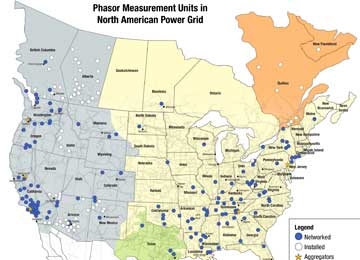
A Synchrophasor Boom
May 11, 2010 - Katherine Tweed - greentechmedia.com

Five years ago, Roy Moxley could barely get anyone to listen as he preached about synchrophasors.Today, Moxley, a marketing manager for synchrophasors at Schweitzer Engineering Laboratories, can barely keep up with installation inquiries.
Integrating synchrophasor devices, a.k.a. phasor measurement units, is one focal point of updating high voltage substations into dynamic centers of real-time information. The devices, which sit in electrical substations, take real-time measurements off of transmission lines about 30 times a second and timestamp them using GPS. They can coordinate measurements from across the country simultaneously, giving a full picture of what is happening on the wider grid and alerting an operator if measurements in two places are out of sync. Now, utilities can obtain data on the pulse of their networks every few seconds, if they are lucky. With these units, utilities ideally can start to prepare themselves better to avoid brown-outs or to accept sudden surges of power from wind or solar farms.
Although the recent attention has been on smart meters, many utilities are also zeroing in on substation automation, which includes synchrophasors, distribution feeder automation and communications networks to relay information faster and with more reliability. (Check out more on smart grid infrastructure at The Networked Grid conference, taking place May 18 and 19 in Palm Springs.)
"The substations are in the heart of the grid and they are the places where we can take the actions necessary to bring in the green power," said Moxley. "This is the real smart grid."
SEL is a major player in substation automation, along with ABB, Macrodyne, Mehta Tech and Siemens. There are also a host of smaller companies entering the market and keeping the old guard on its toes.
Moxley estimates that SEL is actively talking to around 75 utilities about how to integrate synchrophasors into substations, although he said there are many more just placing orders without asking for advice. Various other utilities are also buying synchrophasors from other manufacturers. China, Brazil and Mexico also have robust synchrophasor markets.
Currently, China is the clear leader in the industry, with more than 1,000 units already deployed, according to Arun Phadke, an IEEE Smart Grid Technical Expert and a volunteer for the IEEE Power & Energy Society. He expects to see the U.S., which currently has about 250 units in place, reach that level in the coming years.
"Synchrophasors offer a higher level of intelligence to all [automated substation] functions," said Phadke. "Automation already exists, but synchrophasors brings it closer to optimal automation."
Substation automation is not just about making an individual point smarter, but empowering communications across the grid. "The paradigm shift is that no longer is it simply, 'if this happens, switch this,'" said Wes Sylvester, the Director of Smart Grid for Siemens Energy. Instead, synchrophasors can prevent power swings before they happen, as was the case in New Orleans during Hurricane Gustav, when synchrophasors allowed Entergy to keep the lights on for an estimated 250,000 customers, saving the utility more than $2 million in projected repair costs.
Currently, synchrophasor measurements are used to improve situational awareness, rather than provide true automation, says Alison Silverstein, the project manager for the North American SynchroPhasor Initiative. Currently, only Southern California Edison has automated operations using phasor data. But many other utilities are unfurling strategies around them or already integrating them into their grids. Many of these efforts are being supported by Department of Energy grants.
That is expected to change in coming years as utilities gain more experience using the data and DOE Smart Grid Investment grants with matching private funding bring more than 800 synchrophasors onto the grid.
"Two years ago, there were probably 10 large utilities [integrating synchrophasors]," said Moxley. "It's been a huge growth. It enables utilities to do more with less."
Copyright © 2010 Greentech Media, Inc.
All rights reserved. |



